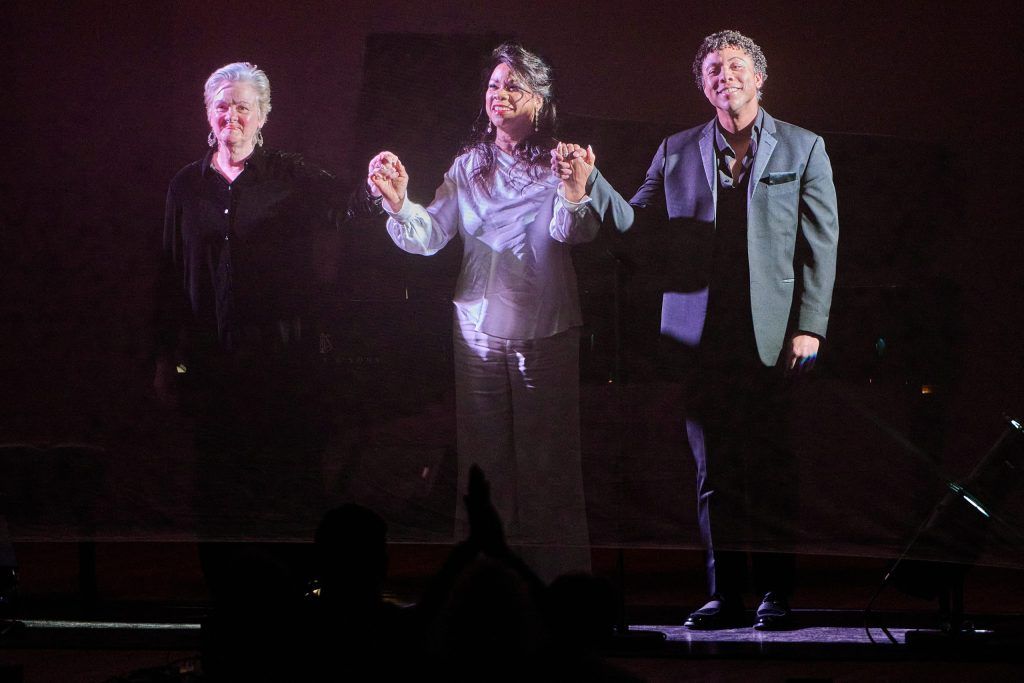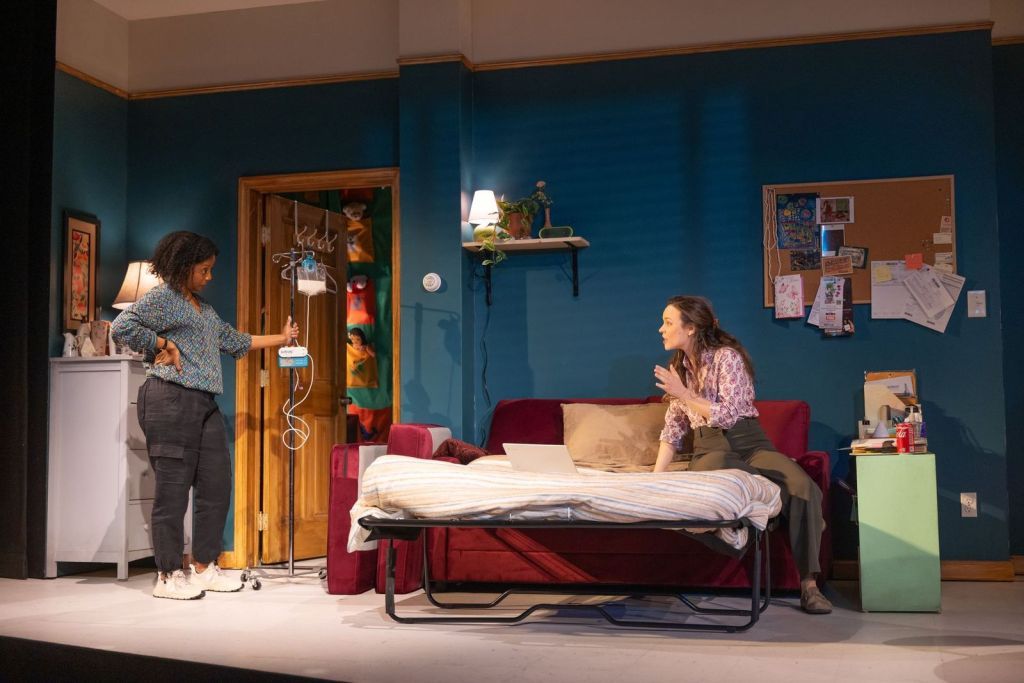Song cycle, photos connect enslaved labor, cotton to power at 92Y

There’s a reason the phrase “King Cotton” exists. According to Historian Sven Beckert in a 2014 article for The Atlantic, by the dawn of the Civil War, cotton production by enslaved people in America “by multiple measures—the sheer numbers employed, the value of output, profitability—the cotton empire had no parallel.” He went on to say, “In 1862, fully 20 million people worldwide…were involved in the cultivation of cotton or the production of cotton cloth…one-tenth of all British capital was invested in it, and close to one-half of all exports consisted of cotton yarn and cloth. Whole regions of Europe and the United States had come to depend on a predictable supply of cheap cotton.” In light of this and in light of the numerous films made about slavery, it is interesting that, blaxploitation comedy Cotton Comes To Harlem notwithstanding, no one has created a serious vehicle with the commodity of cotton at its center—until now.
Last week the song cycle (a group of songs that are designed to be performed together that usually have a theme but not a traditional plot) called “COTTON” was performed at the 92nd Street Y. Starring opera icon Denyce Graves (Carmen, Samson et Dalila) and Drama Desk nominee Justin Austin (Hamlet, Fire Shut Up in My Bones), the production was inspired by images shot by celebrated photographer, painter, printmaker, and lithographer John Dowell, whose artwork is represented in the permanent collections of over 70 museum and public collections.
Dowell’s haunting images of South Carolina cotton fields captured in his 2018 exhibit “Cotton: The Soft, Dangerous Beauty of the Past,” loom over the entire production. The work was composed by the prolific Damien Geter and performed by Graves with exciting rising star baritone Justin Austin, with original poems by a number of contemporary poets.
Taking place in the wood-paneled Kaufmann Concert Hall, the program was a multidisciplinary display of video, still images, and live voice. There was live piano accompaniment by Laura Ward, who also co-founded Lyric Fest, who originally commissioned the production. The program began with a John Dowell voiceover prologue, along with a carousel of his images projected onto a triptych screen made of a grayish mesh that encompassed the entire length of the stage, and almost the entire height. He discusses his relationship with the images he shot, his narration often eliciting laughter from the packed audience.
RELATED: NY born & bred opera singer Justin Austin shines in ‘COTTON’ at 92Y
Following Dowell was a succession of poets performing work they created in response to his photographs: Nikki Giovanni, Marc Bamuthi Joseph, Afaa Michael Weaver, Lauren Alleyne, Charlotte Blake Alston, Glenis Redmond, Alora Young, and Trapeta Mayson were performed against the backdrop of Dowell’s stunning imagery, many of them overlaid with, or overlaying, other images such as contemporary urban landscapes, abstract images, or woodcut illustrations of Black women apparently from the antebellum period.
These images of the women outfitted in white dresses and head wraps gave them an angelic, ephemeral appearance that evoked an inherent humanity, heroism, femininity, and, of course, resilience. They are similar in technique to the work of Elizabeth Catlett though less “grounded” and more airy and ethereal in feel. Video was paused at the conclusion of each poem and Graves and Austin took turns following with a performance in song.
There was an interesting juxtaposition between the performances of the poets, Graves, and Austin. The poets were recorded performing in everyday clothing, infusing their performances with rhythms, beats, and gesticulations of jazz, R&B, hip-hop, and other forms associated with spoken word poetry. After each poet’s performance, the videos were poised so Austin and Graves, outfitted in formal suits (she in all white, and he in all black), performed using the same text as their librettos, bathing their words in a delicate, determined, soaring spirituality. One of the recurring images across different poems is a street sign for Wall St. Of course Wall Street was once the site of a slave market. But the image, overlayed by images of cotton, directly connects the importance of enslaved labor with the modern world economy and the wealth and economic domination of cities like New York and nations like the U.S. and England. Though cotton is a ready metonym for slavery and all its horrors, what is often not connected is the astronomical economic value, and thus, global power, attached to the labor itself, which Dowell does in his photography and by extension, what the “COTTON” production reminds us of as well.
The post Song cycle, photos connect enslaved labor, cotton to power at 92Y appeared first on New York Amsterdam News.
EMU celebrates Black History Month with a full slate of events – EMU News – Eastern Mennonite University
EMU celebrates Black History Month with a full slate of events – EMU News Eastern Mennonite University
6 Tips For A Calm Home Renovation Experience In Harlem And Beyond
The #1 source in the world for all things Harlem.
Are you planning to renovate your home? Home renovation can be a daunting and stressful experience for many homeowners. However, it doesn’t have to be that way. With the right approach and mindset, you can turn your home renovation into a calm and enjoyable experience. In this article, we will share 6 tips that will…
The post 6 Tips For A Calm Home Renovation Experience In Harlem And Beyond appeared first on Harlem World Magazine.
NYC Second Chance Rescue Hosts 4th Annual Rescue Ball Gala With Don Lemon, Mike Woods And Many More
The #1 source in the world for all things Harlem.
NYC Second Chance Rescue held their 4th annual Rescue Ball Gala, at Sony Hall in New York City. The Rescue Ball is the Charity’s largest Life-Saving event of the year. The Gala honored, Jenny Mollen, Jason Biggs, and Wayne Schumer, with the “Angel & Hero Award” for their dedication to animal welfare. Tony and Grammy Award-nominated actress and Singer, Orfeh hosted…
The post NYC Second Chance Rescue Hosts 4th Annual Rescue Ball Gala With Don Lemon, Mike Woods And Many More appeared first on Harlem World Magazine.
Touro College Of Osteopathic Medicine Receives 2024 Inclusive Alumni Excellence Award
The #1 source in the world for all things Harlem.
Touro College of Osteopathic Medicine (TouroCOM) is the recipient of the 2024 Alumni Association Inclusive Excellence Award from Insight into Diversity magazine, the largest and oldest diversity and inclusion magazine in higher education. The award recognizes TouroCOM’s programs, culture and initiatives that encourage and support diversity, inclusion and a sense of belonging for all alumni regardless of race,…
The post Touro College Of Osteopathic Medicine Receives 2024 Inclusive Alumni Excellence Award appeared first on Harlem World Magazine.
‘Mary Jane’ is touching, moving, theater

With “Mary Jane,” Amy Herzog has written one of the most moving plays you will see on Broadway this season. Playing at the Samuel J. Friedman Theatre (W. 47th Stree), this Manhattan Theatre Club drama beautifully, tenderly, and powerfully reveals the trauma that women can endure when they have severely ill children.
Imagine if your child was unable to speak to you, unable to sit up, or had to be attached to medical equipment while in their stroller. Imagine needing nurses in your home to take care of your child and not being able to have a “normal daily existence” out in the world, at a job or anywhere else, because you are always tending to your children at home or in the hospital. That is the life that Mary Jane has known for two years with her son Alex.
Rachel McAdams is dynamic in this intense role. She handles this character’s pain with a sense of respect and dignity, and beautifully embodies a mother’s love for and dedication to her sick child. You also see that there is a community of families out there who try to help one another.
This play will touch you on many levels, through the sheer trauma that these women go through and their steadfastness when it comes to helping and advocating for their children. They see the beauty in their babies, but also admit to the toll they feel on their lives.
McAdams is part of a cast of five women who are versatile, distinct, and touching as they each play dual roles. April Matthis, as both Alex’s nurse Sherry and Dr. Toros, plays these characters with marvelous care, concern, and heart. Brenda Wehle is memorable as both Ruthie, the building super who has a great deal of empathy for Mary Jane, and Tenkei, a nun at the hospital who comforts Mary Jane while Alex is in surgery. Lily Santiago is engrossing as Amelia and Kat. Amelia is Sherry’s niece, a college student who is shy, sensitive, and caring. In the role of Kat, a music therapist, she is gentle and kind as she plays music to soothe Alex after a procedure.
Susan Pourfar is incredibly touching in her roles as Brianna and Chaya, both mothers of children who are experiencing severe illnesses. Brianna is new to this life and receives detailed tips from Mary Jane about how to get assistance and benefits for her son Seth. As Chaya, she is a mother of seven children, with one daughter who is severely ill and causes her to be in the hospital for months at a time.
Direction by Anne Kaufmann is superb. You will know you have experienced something that is, sadly, a reality for many parents. The set design by Lael Jellinek is fantastic and detailed. Costume design by Brenda Abbandandolo, lighting design by Ben Stanton, and sound design by Leah Gelpe add to the intensity of this truly stunning play.
“Mary Jane” is touching, moving, deep theater. For more info, visit www.manhattantheatreclub.com.
The post ‘Mary Jane’ is touching, moving, theater appeared first on New York Amsterdam News.

